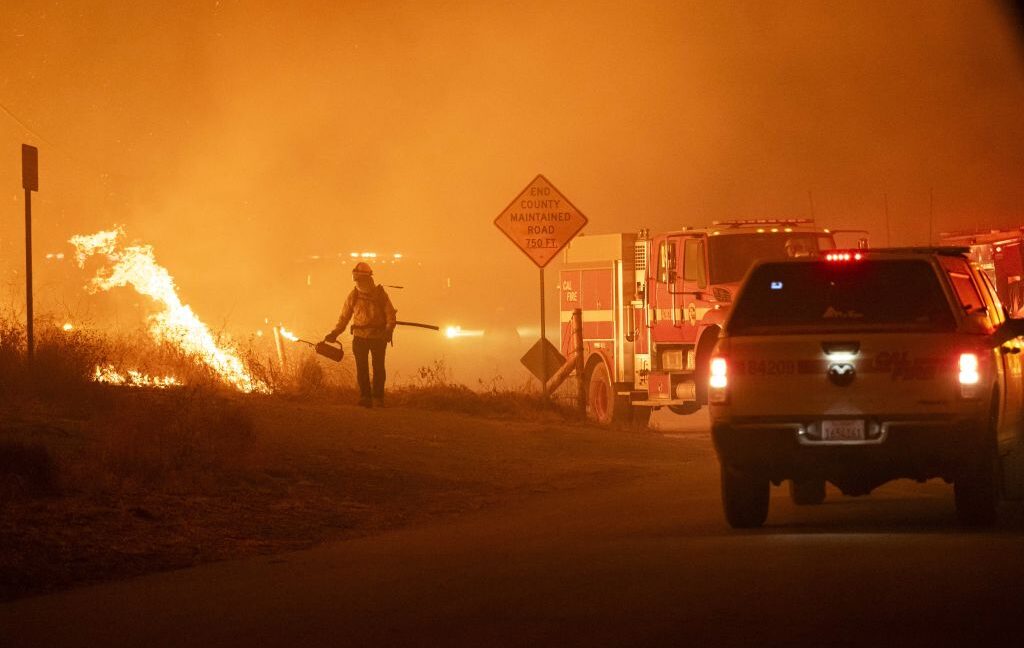
Global warming caused mainly by burning of fossil fuels made the hot, dry, and windy conditions that drove the recent deadly fires around Los Angeles about 35 times more likely to occur, an international team of scientists concluded in a rapid attribution analysis released Tuesday.
Today’s climate, heated 2.3° Fahrenheit (1.3° Celsius) above the 1850-1900 pre-industrial average, based on a 10-year running average, also increased the overlap between flammable drought conditions and the strong Santa Ana winds that propelled the flames from vegetated open space into neighborhoods, killing at least 28 people and destroying or damaging more than 16,000 structures.
“Climate change is continuing to destroy lives and livelihoods in the US,” said Friederike Otto, senior climate science lecturer at Imperial College London and co-lead of World Weather Attribution, the research group that analyzed the link between global warming and the fires. Last October, a WWA analysis found global warming fingerprints on all 10 of the world’s deadliest weather disasters since 2004.
Several methods and lines of evidence used in the analysis confirm that climate change made the catastrophic LA wildfires more likely, said report co-author Theo Keeping, a wildfire researcher at the Leverhulme Centre for Wildfires at Imperial College London.
“With every fraction of a degree of warming, the chance of extremely dry, easier-to-burn conditions around the city of LA gets higher and higher,” he said. “Very wet years with lush vegetation growth are increasingly likely to be followed by drought, so dry fuel for wildfires can become more abundant as the climate warms.”
Park Williams, a professor of geography at the University of California and co-author of the new WWA analysis, said the real reason the fires became a disaster is because “homes have been built in areas where fast-moving, high-intensity fires are inevitable.” Climate, he noted, is making those areas more flammable.
All the pieces were in place, he said, including low rainfall, a buildup of tinder-dry vegetation, and strong winds. All else being equal, he added, “warmer temperatures from climate change should cause many fuels to be drier than they would have been otherwise, and this is especially true for larger fuels such as those found in houses and yards.”
He cautioned against business as usual.
“Communities can’t build back the same because it will only be a matter of years before these burned areas are vegetated again and a high potential for fast-moving fire returns to these landscapes.”
The series of five major fires started January 7 and were mostly contained by January 28, when some rain and snow fell in the affected areas, but not before disrupting the lives of tens of thousands of people and increasing long-term health risks to people who had to breathe the smoke from burning vegetation and urban structures.
After several days of official warnings about extreme fire conditions, and despite efforts to reduce the risk by shutting down some power lines, winds of up to 100 mph pushed flames, fire tornadoes, smoke, and thick curtains of burning embers down through rugged canyons overgrown with dry grass, brush, and trees in areas like Pacific Palisades, between Santa Monica and Malibu, as well as parts of Pasadena and Altadena. In most of those areas, fences, decks, landscaping, and homes themselves were the fuel for what is projected to be the costliest climate-linked disaster on record in the United States.
The new attribution analysis was done by 32 researchers, including leading wildfire scientists from the US and Europe as part of World Weather Attribution, which has studied the influence of climate change on more than 90 extreme events around the world. The scientists warned that the likelihood of dangerously fire-prone conditions will increase by another 35 percent if global warming reaches 4.7° Fahrenheit (2.6° Celsius), as projected by 2100.
To evaluate how warming affected the fires, the researchers used a peer-reviewed method that combines observed weather data with climate models. The calculations show that many of the factors contributing to the conflagrations are intensified in a warmer climate.
Low rainfall in the Southern California region from October to December is about 2.4 times more likely, and fire-prone conditions in the region last 23 days longer now than in the pre-industrial climate, the scientists said. They noted that the relatively small geographic study area added some uncertainty to the equation, especially with regard to how warming affects seasonal rainfall, which has always been quite variable and is also shaped by much larger regional drivers.
Taken together, the results all indicate climate change plays a major role, and the researchers are confident in the findings that warming increases the chances of such fires.
